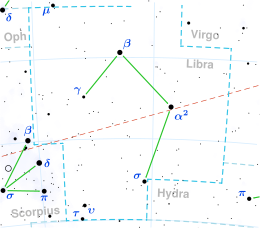Sigma Librae
| Observation data ICRS )
| |
|---|---|
| Constellation | Libra |
| Right ascension | 15h 04m 04.21608s[1] |
| Declination | –25° 16′ 55.0606″[1] |
| Apparent magnitude (V) | 3.20 - 3.46[2] |
| Characteristics | |
| Spectral type | M2.5III[3] |
| U−B color index | +1.94[4] |
| B−V color index | +1.70[4] |
| Variable type | SRb[2] |
| Absolute magnitude (MV) | –1.5[6] |
| Details | |
dex | |
| Database references | |
| SIMBAD | data |
Sigma Librae (σ Librae, abbreviated Sigma Lib, σ Lib) is a
The two components are designated Sigma Librae A (officially named Brachium /ˈbreɪkiəm/,[12] the traditional name for the system)[13] and B.
Nomenclature
σ Librae (Latinised to Sigma Librae) is the system's current Bayer designation (the star originally bore the designation Gamma Scorpii[14] and did not receive its current designation until the new designation was agreed upon by Commission 3 of the International Astronomical Union (IAU) on July 31, 1930.[15]) The designations of the two components as Sigma Librae A and B derives from the convention used by the Washington Multiplicity Catalog (WMC) for multiple star systems, and adopted by the International Astronomical Union (IAU).[16]
It bore the traditional
In
Properties
The primary, Sigma Librae A, has a spectral class M2.5 III,[3] which places it in the red giant stage of its evolution. This is a semi-regular variable star with a single pulsation period of 20 days.[6] It shows small amplitude variations in magnitude of 0.10–0.15 on time scales as brief as 15–20 minutes, with cycles of repetition over intervals of 2.5–3.0 hours.[21] This form of variability indicates that the star is on the asymptotic giant branch and is generating energy through the nuclear fusion of hydrogen and helium along concentric shells surrounding an inert core of carbon and oxygen.[22]
The companion, Sigma Librae B, is of the 16th magnitude and over an arc minute away.[11]
References
- ^ S2CID 18759600.
- ^ Bibcode:2009yCat....102025S.
- ^ S2CID 123149047.
- ^ Bibcode:1978A&AS...34....1N.
- Bibcode:1999VeARI..35....1W.
- ^ .
- ^ S2CID 19007399.
- S2CID 49573767.
- ^ S2CID 42053871
- ^ "sig Lib -- Semi-regular pulsating Star", SIMBAD, Centre de Données astronomiques de Strasbourg, retrieved 2012-01-14.
- ^ a b c "Washington Double Star Catalog". United States Naval Observatory. Archived from the original on 14 February 2011. Retrieved 2 January 2018.
- ^ "brachium". Oxford English Dictionary (Online ed.). Oxford University Press. (Subscription or participating institution membership required.)
- ^ a b "Naming Stars". IAU.org. Retrieved 16 December 2017.
- ISBN 0486235688.
- ^ "Report of Commissions: Ephemerides", Transactions of the International Astronomical Union, 4: 20, 1932.
- arXiv:1012.0707 [astro-ph.SR].
- ^ "IAU Working Group on Star Names (WGSN)". Retrieved 22 May 2016.
- ^ "WG Triennial Report (2015-2018) - Star Names" (PDF). p. 5. Retrieved 2018-07-14.
- ISBN 978-986-7332-25-7.
- ^ (in Chinese) AEEA (Activities of Exhibition and Education in Astronomy) 天文教育資訊網 2006 年 6 月 28 日
- S2CID 122054736.
External links
- Kaler, James B., "ZUBENHAKRABI (Sigma Librae = Gamma Scorpii)", Stars, University of Illinois, retrieved 2012-03-22

